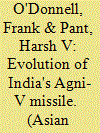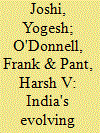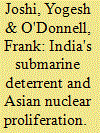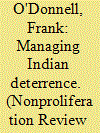|
|
|
Sort Order |
|
|
|
Items / Page
|
|
|
|
|
|
|
| Srl | Item |
| 1 |
ID:
131670


|
|
|
|
|
| Publication |
2014.
|
| Summary/Abstract |
India's Agni-V missile test of April 2012 opens new questions as to India's intentions. This article investigates three principal bureaucratic determinants of Indian military nuclear policy. Greater control over policymaking is required from the Prime Minister's Office to resolve governance questions surrounding India's nuclear policy.
|
|
|
|
|
|
|
|
|
|
|
|
|
|
|
|
| 2 |
ID:
151969


|
|
|
|
|
| Publication |
New Delhi, Alpha Editions, 2017.
|
| Description |
xvi, 82p.pbk
|
| Standard Number |
9789386367754
|
|
|
|
|
|
|
|
|
|
|
|
Copies: C:1/I:0,R:0,Q:0
Circulation
| Accession# | Call# | Current Location | Status | Policy | Location |
| 058984 | 358.17054/JOS 058984 | Main | On Shelf | General | |
|
|
|
|
| 3 |
ID:
178088


|
|
|
|
|
| Summary/Abstract |
In its Eurasian diplomacy toward Russia and China, India has preferred to engage these states bilaterally and through the Brazil–Russia–India–China–South Africa (BRICS) and Shanghai Cooperation Organization (SCO) multilateral alignments. By contrast, India views the Russia–India–China (RIC) triangle as a less effective mechanism. However, despite its ongoing militarized crisis with China in the spring/summer of 2020, India surprisingly agreed to participate in a meeting of RIC foreign ministers and initiate RIC defence ministers' engagements. India also initiated the revival of RIC summits in 2018. This article analyzes the drivers for India's recent shift toward enhancing RIC. Drawing upon Indian policy statements and alignment documents, the article firstly argues that India generates policy agenda overlaps across RIC, BRICS and SCO, which facilitate forum-shopping. Introducing the case-study of Indian counterterrorism diplomacy across the three alignments, the article secondly argues that Indian dissatisfaction with its progress in advancing a security policy agenda within one grouping leads it to refocus on building this agenda in alternative alignments. This article contributes to conceptualizing multi-alignment management, while providing new insights into Indian relations with Russia and China within multilateral institutions and diplomacy in the era of regime complexity.
|
|
|
|
|
|
|
|
|
|
|
|
|
|
|
|
| 4 |
ID:
132474


|
|
|
|
|
| Publication |
2014.
|
| Summary/Abstract |
New Delhi's plans for nuclear-armed submarines could undermine efforts to restrict fissile materials, and set off a naval arms race.
India has become a more or less accepted member of the global nuclear order, but the state's emerging undersea deterrent continues to be a source of concern. Its efforts to create nuclear-armed submarines began in the 1980s, and technical progress was slow during the project's first three decades. India has recently made some bold strides, however, and in 2009 unveiled its first nuclear submarine, INS Arihant. The boat is now undergoing sea trials, and is scheduled to be introduced into the Indian Navy by early 2015. Several similar vessels are under construction: New Delhi plans to field a fleet of between four and six nuclear-armed submarines by the end of the decade.
|
|
|
|
|
|
|
|
|
|
|
|
|
|
|
|
| 5 |
ID:
167793


|
|
|
|
|
| Summary/Abstract |
India is developing new nuclear force options in response to what it perceives as a deteriorating strategic environment. New Delhi has historically adhered to the nuclear strategic concept of “credible minimum deterrence,” defined as maintaining a small, survivable nuclear force at low readiness in peacetime, which poses a credible risk of nuclear retaliation to adversaries but does not guarantee it. However, India’s stated commitment to credible minimum deterrence is currently challenged by four specific developments: the gradual weakening of elite support for India’s no-first-use policy; the decision of its defense scientific agency to pressure policy makers by publicly announcing it can field tactical nuclear weapons; the shift of Indian Air Force planning toward potential counterforce strikes; and New Delhi’s unclear intentions concerning ballistic-missile defense. This article concludes that India faces a choice between two distinct nuclear-policy pathways: retaining its adherence to credible minimum deterrence, or permitting increasing ambiguity surrounding its true nuclear doctrine and posture. The article evaluates these nuclear-policy options and concludes that credible minimum deterrence remains more consistent with Indian national-security and foreign-policy goals.
|
|
|
|
|
|
|
|
|
|
|
|
|
|
|
|
| 6 |
ID:
174627


|
|
|
|
|
| Summary/Abstract |
The threat of nuclear war appears to be growing as we enter the third decade of the 21st century. Washington and Moscow, which together hold over 90 percent of the world’s nuclear weapons, are gradually discarding the international agreements designed to structurally reduce and limit their nuclear force postures. 1 The recent US withdrawal from the bilateral 1987 Intermediate-Range Nuclear Forces (INF) Treaty, following Russian violations, now permits these states to begin constructing and fielding previously banned ground-launched ballistic and cruise missiles with ranges between 500 and 5,500 kilometers.
|
|
|
|
|
|
|
|
|
|
|
|
|
|
|
|
|
|
|
|
|